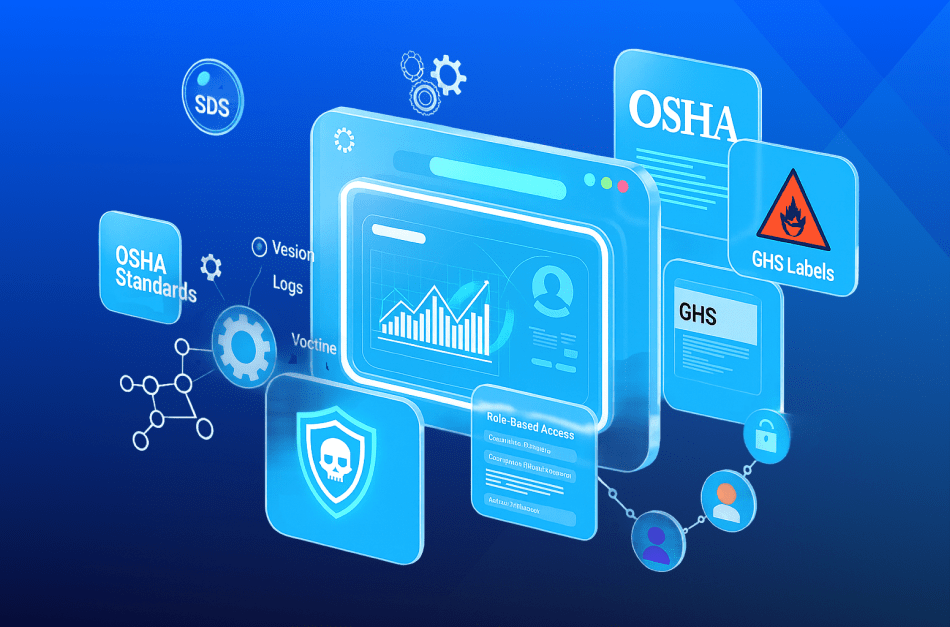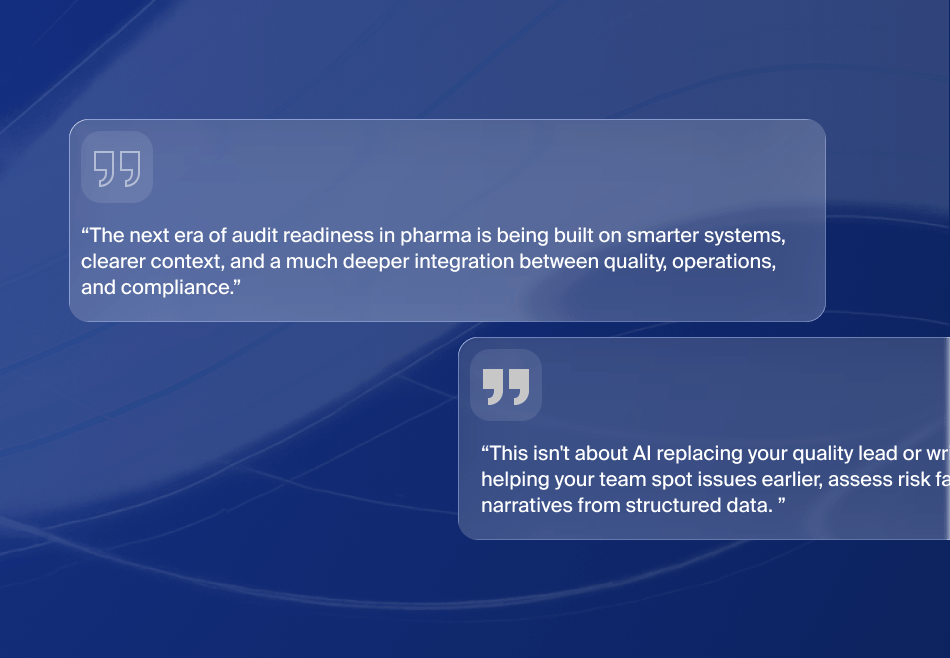At a Glance
- Hazardous Chemicals have harmful effects on the environment and people, and it becomes the company’s responsibility to manage the hazards appropriately.
- With strong risk assessment in place, adhering to best practices, and complying with regulatory norms, companies can potentially reduce the chemical hazards.
- An information system that holds chemical data helps companies comply with regulatory standards such as OSHA, GHS, etc., to reduce risk and improve safety standards.
- Safety Data Sheets and Label management systems help chemical companies manage hazard information and safely label hazardous chemicals.
Hazardous Chemicals Are Everywhere
Chemicals are found everywhere around us in almost every consumer product, from household electronic appliances such as televisions, refrigerators, and personal computers to home goods like furniture, carpets, cleaning supplies, and more. We use chemicals to purify our drinking water, increase crop production and simplify everyday household chores.
As beneficial as chemicals are, many chemicals are hazardous and need to be managed safely or can pose a serious threat to human life and the environment. Very few industries and trades in the world are absolved from chemical exposure. Accidents with chemicals can occur during production, storage, transportation use, or even disposal. Your organization and our community are at risk if chemicals are used unsafely or released into the environment where we live, work and play. Hazardous chemicals can lead to serious injury, long-lasting health effects, property damage and, in worse cases, death.
A report from the American Chemistry Council (ACC) stated that more than 96% of all manufacturing companies utilize chemical substances to develop their products.
There are reports of chemical-related accidents in organizations where it was least expected, such as the food industry.
- Per a 2014 ABC News report a restaurant in Utah, where a woman mistakenly served a tea tainted with Lye. An employee mistook an unlabeled powdered degreaser – containing sodium hydroxide, or lye – for sugar. This degreaser was then accidentally mixed into a cup of tea, causing extreme burns to the customer’s throat and mouth. This led to expensive penalties, lawsuits, and medical bills, as well as severe damage to the business’s reputation.
- Another such incident occurred when customers of a significant ice-cream chain were accidentally served vanilla shakes tainted with a hazardous cleaning chemical. This happened when an employee unknowingly used what was thought to be a clean mixing container. The container contained traces of a degreaser which had not been adequately cleaned, leading to extreme burns to the customer’s throats and mouths. Again, this led to expensive penalties, lawsuits, medical bills and severe damage to the business’s reputation.
Both incidents above could have been avoided with proper labeling and handling practices in place.
Figure: 1Some points to consider when you are a chemical company

The impact that improper handling of hazardous chemicals have on your company can be severe – causing irreparable damage to your reputation, large penalties, being shut down, or worse, endangering human life. It is these dangers and the growing list of hazardous chemical regulations from agencies like OSHA, GHS, etc. that are driving companies to take corrective measures in identifying and eliminating these hazardous chemicals, which pose a threat to your organization, employees, customers and all other stakeholders involved.
Eliminating hazardous chemicals from common and business use is a significant challenge, and it cannot happen overnight.
- In 2014, Adidas declared plans to eliminate the utilization of long-chain perfluorinated compounds (PFCs), a chemical type known to cause asthma and osteoarthritis in children and women. Once developed, this took two years to implement successfully.
- In 2014, the national superstore chain Walmart initiated a policy in which it became mandatory for suppliers to phase out certain hazardous chemicals found in cosmetics, household cleaners etc. This was not a fast transition. They wouldn’t even begin to report publicly on the progress until 2016.
- Apple eliminated using two particularly toxic chemicals, benzene and n-hexane, from its manufacturing assembly process when pressured during a campaign by Green America and China Labor Watch (CLW). The company ordered detailed testing of substances at the ingredient level to ensure the two toxins are rooted out from the facilities, as reported by Global Manufacturing.
These examples highlight one aspect of the challenges involved in successfully removing hazardous chemicals from your organization. It may not even be possible. So, if eliminating hazardous chemicals is not possible, they should be managed better to minimize or prevent chemical-related accidents.
Managing chemical footprint is not just an OSHA compliance but more a civic duty
On August 6, 2014, in a leading copper-producing company suffered a tank leakage of of copper sulphate acid contaminating two rivers and turning them orange and extremely toxic leaving more than 24,000 people to survive without water.
As a consequence, the company had to bear huge penalties and clean-up costs as well as criminal charges filed by the Mexican Government.
In recent times, this incident was a wake-up call for companies regarding the global concern chemicals have on employees, public and environmental health & safety. It also was one of the driving forces behind more stringent legislation on the use of chemicals.
Best Practices & Ways to remain compliant
Regulatory Compliance is something that cannot be forgotten, as non-compliance attracts unwanted attention from regulatory agencies – often followed by large penalties as well as a threat to your business’s licenses.
In the US in 2017, the Occupational Safety and Health Administration (OSHA) increased the severity of penalties by 80% and imposed heavy fines ranging from $7,000 up to $12,000 for noncompliance to GHS through 2016-17. For serious violations, the penalties could be as high as $70,000 to $127,000.
Organizations can avoid such fines, unwanted attention from regulatory agencies, and better manage the use of hazardous chemicals to remain compliant are as follows:
- Adhering to regulatory norms and best practices – conducting risk assessments & safety audits for environmental hazards – offering ongoing safety training, reduces humans’ exposure to hazardous chemicals.
- Companies should comply with the global rules, standards, policies and procedures for environmental, health and chemical safety in the workplace. They need to operate environmentally safe facilities and manufacture safe products.
- Smart SDS Management and Labeling applications are designed with managing the impact of hazardous chemicals. This helps your organization’s compliance with hazardous chemical regulations defined by agencies like OSHA, REACH, GHS, FDA, etc.
- Chemical manufacturers need to ensure their products are correctly labeled according to GHS standards.
- They should also strive to remain compliant with all other regulatory policies, industry standards, and government policies to ensure safety management.
- Periodic testing should be performed to ensure that chemicals will not cause harm public health, and if they do, they should be either re-formulated or correctly labeled.
Integrated Technology to manage chemical data
Having the right technology in place can simplify everything we do. Thankfully, most of the issues we mentioned can be taken care of with the help of applications that house chemical information designed to efficiently help chemical companies meet regulatory obligations for compliance and safety.
Figure: 2The GHS process for companies carrying harmful chemicals

What is a Chemical Management system and how does it help Chemical Companies with compliance?
A Chemical Management system – integrated within an ERP like Microsoft Dynamics 365 platform – helps chemical companies with their SDS Management, Label Management and DEA controls in-line with transactions within the operational ERP system. An ideal solution can help with the following:
Regulatory Compliance
- Helps chemical companies comply with regulatory standards and government policies such as OSHA, REACH, FDA, HIPAA, LCSA, DEA to reduce risks and improve safety.
Key Product Functions
- Offers SDS Management, Label Management (incl. Private Labels) & DEA Management in one application.
Label Printing
- An included Label Management function enables chemical companies to automatically print OSHA chemical labels according to the Globally Harmonized System (GHS) labeling standards. These labels can be embedded within the workflow of key operational transactions such as Production Orders, eliminating the need for manual intervention.
SDS Management
- A SDS Management & Authoring system allows companies to maintain Safety Data Sheets (SDS).
- Infrastructure to maintain all 16 sections of the safety data sheet – by country, language, major and minor versions.
- Note that while an application provides the technology, workflows, and infrastructure to maintain chemical data and information, it is essential to verify the information and approve the information before generating the safety data sheet.
Key Takeaways
- Chemical companies must accurately label chemicals in adherence to regulatory standards related to the storage, transportation, handling and disposal of hazardous materials and waste.
- Ongoing training and proper labeling ensure chemical health and safety for the consumers and the companies handling hazardous chemicals.
- Utilizing the right technology reduces input needed when generating labels and helps streamline the processes to ensure your organization remains compliant year after year.
Are you ready for an Agile Cloud-based ERP system for Chemical?








